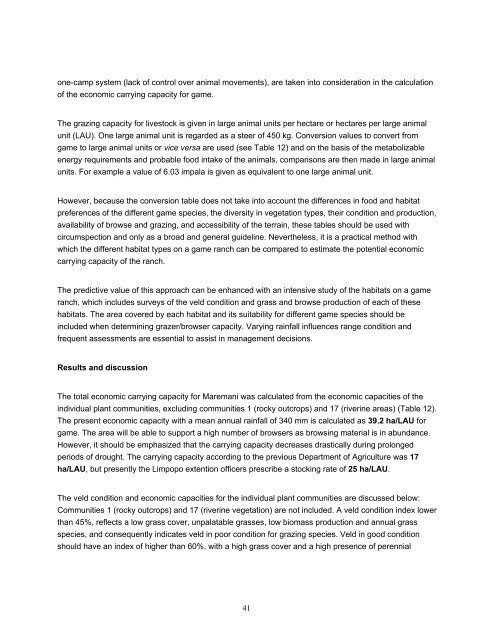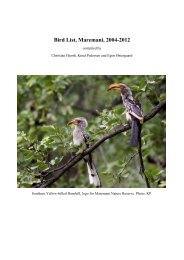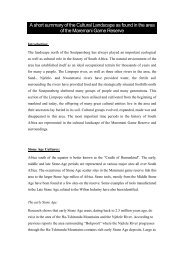the vegetation types and veld condition - Maremani Nature Reserve
the vegetation types and veld condition - Maremani Nature Reserve
the vegetation types and veld condition - Maremani Nature Reserve
Create successful ePaper yourself
Turn your PDF publications into a flip-book with our unique Google optimized e-Paper software.
one-camp system (lack of control over animal movements), are taken into consideration in <strong>the</strong> calculation<br />
of <strong>the</strong> economic carrying capacity for game.<br />
The grazing capacity for livestock is given in large animal units per hectare or hectares per large animal<br />
unit (LAU). One large animal unit is regarded as a steer of 450 kg. Conversion values to convert from<br />
game to large animal units or vice versa are used (see Table 12) <strong>and</strong> on <strong>the</strong> basis of <strong>the</strong> metabolizable<br />
energy requirements <strong>and</strong> probable food intake of <strong>the</strong> animals, comparisons are <strong>the</strong>n made in large animal<br />
units. For example a value of 6.03 impala is given as equivalent to one large animal unit.<br />
However, because <strong>the</strong> conversion table does not take into account <strong>the</strong> differences in food <strong>and</strong> habitat<br />
preferences of <strong>the</strong> different game species, <strong>the</strong> diversity in <strong>vegetation</strong> <strong>types</strong>, <strong>the</strong>ir <strong>condition</strong> <strong>and</strong> production,<br />
availability of browse <strong>and</strong> grazing, <strong>and</strong> accessibility of <strong>the</strong> terrain, <strong>the</strong>se tables should be used with<br />
circumspection <strong>and</strong> only as a broad <strong>and</strong> general guideline. Never<strong>the</strong>less, it is a practical method with<br />
which <strong>the</strong> different habitat <strong>types</strong> on a game ranch can be compared to estimate <strong>the</strong> potential economic<br />
carrying capacity of <strong>the</strong> ranch.<br />
The predictive value of this approach can be enhanced with an intensive study of <strong>the</strong> habitats on a game<br />
ranch, which includes surveys of <strong>the</strong> <strong>veld</strong> <strong>condition</strong> <strong>and</strong> grass <strong>and</strong> browse production of each of <strong>the</strong>se<br />
habitats. The area covered by each habitat <strong>and</strong> its suitability for different game species should be<br />
included when determining grazer/browser capacity. Varying rainfall influences range <strong>condition</strong> <strong>and</strong><br />
frequent assessments are essential to assist in management decisions.<br />
Results <strong>and</strong> discussion<br />
The total economic carrying capacity for <strong>Maremani</strong> was calculated from <strong>the</strong> economic capacities of <strong>the</strong><br />
individual plant communities, excluding communities 1 (rocky outcrops) <strong>and</strong> 17 (riverine areas) (Table 12).<br />
The present economic capacity with a mean annual rainfall of 340 mm is calculated as 39.2 ha/LAU for<br />
game. The area will be able to support a high number of browsers as browsing material is in abundance.<br />
However, it should be emphasized that <strong>the</strong> carrying capacity decreases drastically during prolonged<br />
periods of drought. The carrying capacity according to <strong>the</strong> previous Department of Agriculture was 17<br />
ha/LAU, but presently <strong>the</strong> Limpopo extention officers prescribe a stocking rate of 25 ha/LAU.<br />
The <strong>veld</strong> <strong>condition</strong> <strong>and</strong> economic capacities for <strong>the</strong> individual plant communities are discussed below:<br />
Communities 1 (rocky outcrops) <strong>and</strong> 17 (riverine <strong>vegetation</strong>) are not included. A <strong>veld</strong> <strong>condition</strong> index lower<br />
than 45%, reflects a low grass cover, unpalatable grasses, low biomass production <strong>and</strong> annual grass<br />
species, <strong>and</strong> consequently indicates <strong>veld</strong> in poor <strong>condition</strong> for grazing species. Veld in good <strong>condition</strong><br />
should have an index of higher than 60%, with a high grass cover <strong>and</strong> a high presence of perennial<br />
41




